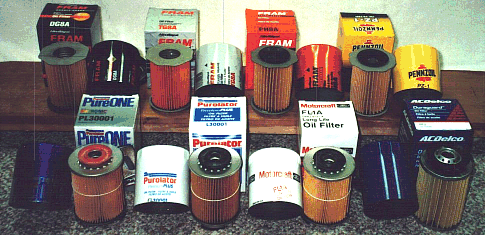



Engine Oil Filter StudySPECIAL FEATURES: Mopar Filters, German Filters |
[ Warning | Disassembly
and Measurements | SAE Tests | Mopar
Conversion Table | Conclusions ]
[ AC Delco | AMSOIL |
Car
And Driver | Champ | Deutsch
| Fram | Hard Driver | Mobil
1 | Motorcraft | NAPA
| Pennzoil | PowerFlo |
ProLine
| Purolator |
Quaker State
| STP | Wix ]
UPDATE: To help reduce some of my email traffic from this
page, I have created an FAQ. Before emailing me with a question,
please read the
Oil Filter Study Frequently
Asked Questions first. I typically don't respond to questions
that are already answered here.
- AC Delco Ultraguard Gold PF2
- Amsoil SDF15
- Bosch
- Fram HP1
- Hard Driver HD01
- K&N Gold
- Penske
- Purolator HP1/L390001
The primary shortcoming of this study is the small sampling size. I only tested the Ford 5.0L filter. It has come to my attention that some brand names use different manufacturers for different applications. Another shortcoming is the lack of testing of the filter element media itself. Unfortunately I have neither the time nor resources to do this.
I invite anyone with the means to take a larger sampling size and conduct a more complete study, which may include private SAE tests. I also invite anyone to repeat a study similar to this one on other model filters.
With all of that said, please make your own judgements. Use this study only as a source of some information that may give you a better idea about which filter brands to steer clear from. It should be obvious that some manufacturers are not being honest about their product. The next time you buy a filter for your car, buy two and hack one open to see what you have. My intent was to give you some information and alert you to some little-known issues, not to tell you what to think.




AC Delco Duraguard PF2
AC Delco Ultraguard Gold PF2
AMSOIL SDF15
Baldwin B2
Bosch ???
Car And Driver SF-1A
Champ
Deutsch D539
Deutsch D545
Fram Extra Guard PH8A
Fram Tough Guard TG8A
Fram Double Guard DG8A
Hard Driver HD01
Mobil 1 M1-301
Motorcraft FL-1A
NAPA Gold 1515
Pennzoil PZ-1
PowerFlo SL30001
ProLine PPL-30001
Purolator Premium Plus L30001
Purolator Premium Plus L390001
Purolator Pure One PL30001
Quaker State Q58A
STP S-01
Wix 51515
I hope to add more brands to this study as I can acquire them. The analysis is sorted by brand name in alphabetical order. In each brand section, I have broken the information down into the brand name models, sorted by price. Pictures coming soon!
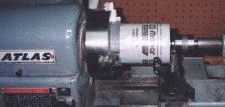
The sections below detail each of the filters I tested. A summary of
the measurements I took can be found in a table for each. I noticed that
other filter part numbers for the same brand were designed a bit differently.
This is probably because of the shape of the can and the requirements for
that engine. Here is a description of each table entry:
| Average Retail Price | The average of all the retail prices I found for this filter (to the nearest $0.50) |
| Cartridge Length | The length of the filter cartridge, including end caps |
| Cartridge Outside Diameter | The outside diameter of the filter cartridge element pleats |
| Cartridge Inside Diameter | The inside diameter of the filter cartridge inside support tube |
| Cartridge Pleats | The number of pleats (or folds) in the element while in the cartridge |
| Cartridge End Cap Type | The type of material used to construct the end caps |
| Anti-Drainback Valve Type | The valve design and construction material |
| Bypass Valve Type | The valve design and construction material |
| Element Type | The type of material used to construct the filter element and the seam seal |
| Element Length | The overall length of the element when removed from the cartridge and stretched out |
| Element Width | The width of the stretched-out element |
| Element Surface Area | The calculated surface area of the cartridge using the above two values |
| Shell Thickness | The thickness of the metal used to construct the filter's shell |
| Backplate Thickness | The thickness of the metal used to construct the filter's backplate |
| Gasket Type | The type of material used to construct the backplate sealing gasket (O-ring) |
| Hydrostatic Burst Pressure | Since I cannot test this myself, I have removed this data. |
| SAE J806 Filtration Efficiency | Since I cannot test this myself, I have removed this data. |
| SAE J1858 Filtration Efficiency | Since I cannot test this myself, I have removed this data. |
The construction of the anti-drainback and bypass valves is an important feature. Many are made of nitrile rubber. As long as they have good sealing surfaces, they generally work fine. However, nitrile rubber diaphrams gets stiff in extreme cold and may fail to seal in those conditions. Silicone rubber seals or steel valves are not prone to this. Many bypass valves are spring-loaded steel and work well. Some are spring-loaded plastic and are often not molded well enough to make a decent seal, allowing oil to leak passed them.
Probably the most important value here is the element surface area. This helps determine the amount of filter media that is available to trap particles. Cellulose media (basically paper) can trap fewer particles and can flow less oil per square inch because there are fewer passages through it. Synthetic media has more passages and can trap more particles and flow more oil than cellulose per square inch. For the same type of media, the smaller the area, the sooner the filter will become plugged and will end up bypassing much of the oil instead of filtering it. Some filters use a cellulose/synthetic blend, so a direct comparison is not possible. More pleats in the element does not necessarily mean more surface area (as you will soon see). In fact, too many pleats can end up restricting the flow too much because there is not enough space between them to allow oil to flow. Most of the cheaper filters use a mix that is mostly cellulose. Some of the better filters use synthetics or synthetic blends. I'll try to come up with some way of identifyiong these.

The shell and backplate thickness are only relevant if your engine's oil system operates at unusually high pressures. Occasionally a seemingly strong filter can still leak due to a failure at the crimp between the can and backplate. If this happens to you, I would send it back to the manufacturer so that they can solve the problem. Even the cheapest filters have to be strong enough for stock oiling systems, or they will fail SAE tests.
I have removed SAE filtration efficiency and all other data that came from the manufacturers, since these are often inaccurate numbers.
Other measurements and values are debatable and I will allow you to draw your own conclusions from them.
The SAE J806 test uses a single-pass test, checking for contaminant holding capacity, size of contaminant particles trapped, and ability to maintain clean oil. As an amendment of the J806 test, the multi-pass test also looks for filter life in hours, contaminant capacity in grams, and efficiency based on weight. The efficiency of the filter is determined only by weight through gravimetric measurement of the filtered test liquid. Typical numbers for paper filter elements are 85% (single pass) and 80% (multi-pass).
The SAE J1858 test provides both particle counting and gravimetric measurement to measure filter capacity and efficiency. Actual counts of contaminant particles by size are obtained every 10 minutes, both upstream (before the filter) and downstream (after the filter), for evaluation. From this data filtration ratio and efficiency for each contaminant particle size can be determined as well as dust capacity and pressure loss as a function of time. Typical numbers for paper element filters are 40% at 10 microns, 60% at 20 microns, 93% at 30 microns, and 97% at 40 microns.
NOTICE: Since all of the SAE data I have is from the manufacturers, it cannot be trusted to be truthful. Therefore all SAE data has been removed from the filter sections below.
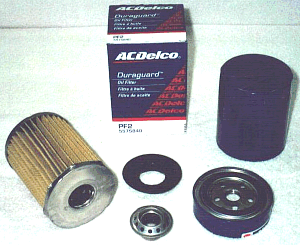 The
filter cartridge has a large outside diameter with deep pleats. At first
glance, it appears to have little filter element media, but the surface
area measure was surprising: 315 sqin. The unit had a solid top end cap
because the bypass valve is at the bottom, which is a well constructed
spring-loaded steel with a nitrile seal design. The nitrile rubber diaphram-type
anti-drainback valve doubles as the seal between the bypass valve and the
cartridge. The only drawback to this design is that the bypass valve seats
metal-to-metal against the backplate. This could allow oil from the clean
side of the filter to seep back into the oil pan, but it wouldn't allow
the dirty oil in the filter to seep back. Oil that is in the main gallery
usually leaks out through the main bearings anyway while the engine sits.
One disadvantage to the AC Delco is that the anti-drainback valve seals
against a rough backplate. I noticed that if I blow air through the oil
outlet, air slowly leaks past the valve. Even so, I have been getting testimonials
that the AC Delco stops the valve train noise problems associated with
the Fram filter, so it may seal fine once it has been exposed to oil. The
Wix and Purolator filters seal perfectly.
The
filter cartridge has a large outside diameter with deep pleats. At first
glance, it appears to have little filter element media, but the surface
area measure was surprising: 315 sqin. The unit had a solid top end cap
because the bypass valve is at the bottom, which is a well constructed
spring-loaded steel with a nitrile seal design. The nitrile rubber diaphram-type
anti-drainback valve doubles as the seal between the bypass valve and the
cartridge. The only drawback to this design is that the bypass valve seats
metal-to-metal against the backplate. This could allow oil from the clean
side of the filter to seep back into the oil pan, but it wouldn't allow
the dirty oil in the filter to seep back. Oil that is in the main gallery
usually leaks out through the main bearings anyway while the engine sits.
One disadvantage to the AC Delco is that the anti-drainback valve seals
against a rough backplate. I noticed that if I blow air through the oil
outlet, air slowly leaks past the valve. Even so, I have been getting testimonials
that the AC Delco stops the valve train noise problems associated with
the Fram filter, so it may seal fine once it has been exposed to oil. The
Wix and Purolator filters seal perfectly.
The telltale signs for an AC Delco filter are: Five large holes for the oil inlet and 6 spot welds on the rim surrounding them. There are no crimps holding the gasket in place. When you look through the inlet holes, you can see the metal bypass valve with its 12 small holes and the black anti-drainback valve diaphragm around it. Through the center outlet hole, you can see the spring for the bypass valve.
Exploded view:

| Average Retail Price | $3 |
| Cartridge Length | 4.625 inches |
| Cartridge Outside Diameter | 3.375 inches |
| Cartridge Inside Diameter | 1.375 inches |
| Cartridge Pleats | 36 |
| Cartridge End Cap Type | Stamped steel |
| Anti-Drainback Valve Type | Nitrile rubber diaphragm |
| Bypass Valve Type | Spring-loaded steel |
| Element Type | Paper media, glued seam |
| Element Length | 70.0 inches |
| Element Width | 4.500 inches |
| Element Surface Area | 315 square inches |
| Shell Thickness | 0.015 inches |
| Backplate Thickness | 0.100 inches |
| Gasket Type | Nitrile rubber |
| Average Retail Price | $3 |
| Cartridge Length | 4.000 inches |
| Cartridge Outside Diameter | 3.250 inches |
| Cartridge Inside Diameter | 1.625 inches |
| Cartridge Pleats | 54 |
| Cartridge End Cap Type | Stamped-steel, with bypass valve |
| Anti-Drainback Valve Type | Nitrile rubber diaphragm |
| Bypass Valve Type | Spring-loaded steel, nitrile seal |
| Element Type | Paper media, glued seam |
| Element Length | 87 inches |
| Element Width | 3.875 inches |
| Element Surface Area | 337 square inches |
| Shell Thickness | 0.012 inches |
| Backplate Thickness | 0.102 inches |
| Gasket Type | Nitrile rubber |
The Champion design has metal end caps on the filter cartridge, with the bypass valve stamped right into the bottom end cap like the Purolator. I refer to this as a one-piece filter cartridge. Though definitely not the same design as the Purolator, it does use the same type of leaf-spring-type spacer at the top of the cartridge and the nitrile anti-drainback valve, which doubles as the cartridge-to-backplate seal, at the bottom. One issue is that I sometimes noticed was some rust on the backplate of these filters. Since the rust is usually around by the inlet holes, any loose rust would be caught by the filter.
The telltale signs for a Champion filter are: 6 large holes for the
oil inlet, one of which is larger than the others. Only the black anti-drainback
valve can be seen through the inlet holes. There are 6 large crimps holding
the gasket in place. Through the center outlet hole, you can see the bypass
valve spring. Usually, the backplate metal is dull, or even rusty.
| Average Retail Price | $3 |
| Cartridge Length | 4.000 inches |
| Cartridge Outside Diameter | 3.250 inches |
| Cartridge Inside Diameter | 1.625 inches |
| Cartridge Pleats | 55 |
| Cartridge End Cap Type | Stamped-steel, with bypass valve |
| Anti-Drainback Valve Type | Nitrile rubber diaphragm |
| Bypass Valve Type | Spring-loaded steel, nitrile seal |
| Element Type | Paper media, glued seam |
| Element Length | 88.5 inches |
| Element Width | 3.875 inches |
| Element Surface Area | 343 square inches |
| Shell Thickness | 0.012 inches |
| Backplate Thickness | 0.102 inches |
| Gasket Type | Nitrile rubber |
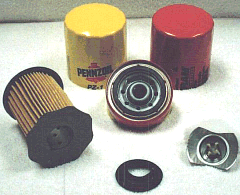 This
filter cartridge has a small outside diameter with a rather low filter
element surface area (193 sqin), and features cardboard end caps that are
glued in place. The rubber anti-drainback valve seals the rough metal backplate
to the cardboard end cap and easily leaks, causing dirty oil to drain back
into the pan. If you have a noisy valve train at startup, this filter is
likely the cause. The bypass valves are plastic and are sometimes not molded
correctly, which allows them to leak. The backplate has smaller and fewer
oil inlet holes, which may restrict flow.
This
filter cartridge has a small outside diameter with a rather low filter
element surface area (193 sqin), and features cardboard end caps that are
glued in place. The rubber anti-drainback valve seals the rough metal backplate
to the cardboard end cap and easily leaks, causing dirty oil to drain back
into the pan. If you have a noisy valve train at startup, this filter is
likely the cause. The bypass valves are plastic and are sometimes not molded
correctly, which allows them to leak. The backplate has smaller and fewer
oil inlet holes, which may restrict flow.
The telltale signs for a Fram Extra Guard are: It has 8 small holes for the oil inlet and a thin, cheap looking backplate, and is currently stamped with a "2Y". There are 5 very small crimps holding the gasket in place. If you look into the center hole all the way to the top of the filter, you will see a kind of "button" in the end cap of the cartridge (which looks like it's made of metal from there). This is the plastic bypass valve.
Exploded view:

| Average Retail Price | $3 |
| Cartridge Length | 4.125 inches |
| Cartridge Outside Diameter | 3.000 inches |
| Cartridge Inside Diameter | 1.375 inches |
| Cartridge Pleats | 34 |
| Cartridge End Cap Type | Cardboard |
| Anti-Drainback Valve Type | Nitrile rubber diaphragm |
| Bypass Valve Type | Spring-loaded plastic |
| Element Type | Paper media, stamped metal seam |
| Element Length | 47.5 inches |
| Element Width | 4.063 inches |
| Element Surface Area | 193 square inches |
| Shell Thickness | 0.015 inches |
| Backplate Thickness | 0.089 inches |
| Gasket Type | Nitrile rubber |
The telltale signs for a Fram Tough Guard filter are: It has a better
backplate that is usually shiny, with six larger holes for the inlet and
6 spot welds around the them. There are 6 large crimps holding the gasket
in place. When you look through the inlet holes, you can see the orange
anti-drainback valve. If you look into the center hole all the way to the
top of the filter, you will see a kind of "button" in the end cap of the
cartridge (which looks like it's made of metal from there). This is the
plastic bypass valve.
| Average Retail Price | $5 |
| Cartridge Length | 4.125 inches |
| Cartridge Outside Diameter | 3.000 inches |
| Cartridge Inside Diameter | 1.625 inches |
| Cartridge Pleats | 50 |
| Cartridge End Cap Type | Cardboard |
| Anti-Drainback Valve Type | Silicone rubber diaphragm |
| Bypass Valve Type | Spring-loaded plastic with integral screen |
| Element Type | Paper media, stamped metal seam |
| Element Length | 61.0 inches |
| Element Width | 4.063 inches |
| Element Surface Area | 248 square inches |
| Shell Thickness | 0.015 inches |
| Backplate Thickness | 0.187 inches |
| Gasket Type | Nitrile rubber, PTFE-treated |
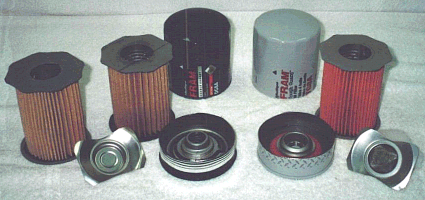
Although it has the lowest filter element surface area (193 sqin), it does have a clever spring-loaded nitrile rubber anti-drainback valve and bypass valve combination.
The telltale signs for a Fram Tough Guard filter are: It has a better
backplate that is usually shiny, with six larger holes for the inlet and
6 spot welds around the them. The backplate should be stamped with a "1K".
There are 6 large crimps holding the gasket in place. The anti-drainback
valve diaphragm behind the inlet holes is black. If you look into the center
hole all the way to the top of the filter, you will not see the "button"
in the end cap of the cartridge (which looks like it's made of metal from
there).
| Average Retail Price | $10 |
| Cartridge Length | 4.125 inches |
| Cartridge Outside Diameter | 3.000 inches |
| Cartridge Inside Diameter | 1.625 inches |
| Cartridge Pleats | 38 |
| Cartridge End Cap Type | Cardboard |
| Anti-Drainback Valve Type | Nitrile rubber diaphragm |
| Bypass Valve Type | Nitrile rubber, integral |
| Element Type | Paper media, stamped metal seam |
| Element Length | 47.5 inches |
| Element Width | 4.063 inches |
| Element Surface Area | 193 square inches |
| Shell Thickness | 0.015 inches |
| Backplate Thickness | 0.187 inches |
| Gasket Type | Nitrile rubber |
| Average Retail Price | $8.50 + $4 shipping |
| Cartridge Length | ? inches |
| Cartridge Outside Diameter | ? inches |
| Cartridge Inside Diameter | ? inches |
| Cartridge Pleats | ? |
| Cartridge End Cap Type | ? |
| Anti-Drainback Valve Type | ? |
| Bypass Valve Type | ? |
| Element Type | Synthetic media |
| Element Length | ? inches |
| Element Width | ? inches |
| Element Surface Area | ? square inches |
| Shell Thickness | ? inches |
| Backplate Thickness | ? inches |
| Gasket Type | ? |
| Hydrostatic Burst Pressure | 200 psi |
| SAE J806 Filtration Efficiency | Unknown |
| SAE J1858 Filtration Efficiency | 95% at 10 microns
98% at 20 microns 98% at 30 microns 98% at 40 microns |
It uses a synthetic fiber element that can filter out very small particles and is very strong. It is rated just under the Purolator Pure One as far as filtering capability, but is still very much above conventional paper filters. It also has a very strong construction to withstand high pressure spikes during start-up. However, as with all Mobil 1 products, expect to pay 2 - 3 times as much for this filter.
I have received many reports of these filters failing at high pressures. It seems that the seam where the backplate crimps to the case can split.
Exploded view:

| Average Retail Price | $10 |
| Cartridge Length | 4.250 inches |
| Cartridge Outside Diameter | 3.250 inches |
| Cartridge Inside Diameter | 1.625 inches |
| Cartridge Pleats | 52 |
| Cartridge End Cap Type | Stamped-steel, with bypass valve |
| Anti-Drainback Valve Type | Nitrile rubber diaphragm |
| Bypass Valve Type | Spring-loaded steel, nitrile seal |
| Element Type | Synthetic media, glued seam |
| Element Length | 85 inches |
| Element Width | 4.125 inches |
| Element Surface Area | 351 square inches |
| Shell Thickness | 0.022 inches |
| Backplate Thickness | 0.138 inches |
| Gasket Type | Nitrile rubber |
Oil filter Study Special Model Feature: Mopar
Like the Purolator Pure One, this filter cartridge features a very large
element surface area (400 sqin), but with many pleats (64). This packs
the filter together rather tightly and may restrict flow somewhat. I could
identify the Pure One element media by a purple dye they use at the seam.
It also has the mysterious assembly string wrapped around the outside of
the element. Like the Purolators, it features a spring-loaded metal bypass
valve and a nitrile rubber diaphram-type anti-drainback valve. The bypass
valve is stamped right into the bottom end cap of the cartridge, so it
is all one piece.
| Average Retail Price | $3 |
| Cartridge Length | 4.125 inches |
| Cartridge Outside Diameter | 3.250 inches |
| Cartridge Inside Diameter | 1.625 inches |
| Cartridge Pleats | 64 |
| Cartridge End Cap Type | Stamped-steel, with bypass valve |
| Anti-Drainback Valve Type | Nitrile rubber diaphragm |
| Bypass Valve Type | Spring-loaded steel |
| Element Type | Paper media, stamped metal seam |
| Element Length | 100.0 inches |
| Element Width | 4.000 inches |
| Element Surface Area | 400 square inches |
| Shell Thickness | 0.011 inches |
| Backplate Thickness | 0.120 inches |
| Gasket Type | Nitrile rubber |
| Average Retail Price | $5 |
| Cartridge Length | 4.000 inches |
| Cartridge Outside Diameter | 3.250 inches |
| Cartridge Inside Diameter | 1.625 inches |
| Cartridge Pleats | 59 |
| Cartridge End Cap Type | Stamped-steel |
| Anti-Drainback Valve Type | Nitrile rubber diaphragm |
| Bypass Valve Type | Spring-loaded steel, nitrile seal |
| Element Type | Paper media, glued seam |
| Element Length | 87 inches |
| Element Width | 3.875 inches |
| Element Surface Area | 337 square inches |
| Shell Thickness | 0.014 inches |
| Backplate Thickness | 0.104 inches |
| Gasket Type | Nitrile rubber |
All the measurements were exactly the same as the Fram Extra Guard PH8A.
| Average Retail Price | $2 |
| Cartridge Length | 4.125 inches |
| Cartridge Outside Diameter | 3.000 inches |
| Cartridge Inside Diameter | 1.375 inches |
| Cartridge Pleats | 34 |
| Cartridge End Cap Type | Cardboard |
| Anti-Drainback Valve Type | Nitrile rubber diaphragm |
| Bypass Valve Type | Spring-loaded plastic |
| Element Type | Paper media, stamped metal seam |
| Element Length | 47.5 inches |
| Element Width | 4.063 inches |
| Element Surface Area | 193 square inches |
| Shell Thickness | 0.015 inches |
| Backplate Thickness | 0.089 inches |
| Gasket Type | Nitrile rubber |
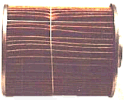 |
|
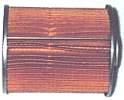 |
As you may be able to tell, the string did not rip into the filter element,
it only crushed it. There was no evidence that the element had been compromised.
Out of the 8 Purolators (and clones) tested, this was the only one with
a problem.
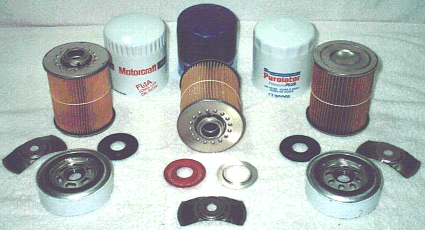
Here is a fairly well designed filter, especially for the price. One odd thing about Purolator's filters is a string that is always wrapped around the filter element. I assume that this is there to hold the element in place while the glue in the end caps cures. Of all the Purolator-based filter I tested, there was one (the ProLine) that had filter element damage from this string. Although it was one of five tested, I am weary of this design. Even though the element was crushed a bit, it was not ripped. I will take apart a used one at my next oil change.
The filter cartridge has an impressive surface area of 316 sqin, which is very close to the AC Delco Duraguard. The difference is that Purolator's filter element is compressed into more pleats (51) than the AC Delco. This may restrict flow somewhat, but not as much in this model than the Pure One. It features a spring-loaded metal bypass valve and a nitrile rubber diaphram-type anti-drainback valve, which doubles as the seal between the backplate and the cartridge. Like the Champion, this bypass valve is stamped right into the bottom end cap of the cartridge, so it is all one piece.
The telltale sign for a Purolator filter are: 8 medium-sized holes for the oil inlet and nothing but a black (or orange for the Pure One) diaphragm to be seen through them. There are 6 large crimps holding the gasket in place. Through the center outlet hole, you can see the spring for the bypass valve.
Exploded view:

| Average Retail Price | $3 |
| Cartridge Length | 4.125 inches |
| Cartridge Outside Diameter | 3.250 inches |
| Cartridge Inside Diameter | 1.625 inches |
| Cartridge Pleats | 51 |
| Cartridge End Cap Type | Stamped-steel |
| Anti-Drainback Valve Type | Nitrile rubber diaphragm |
| Bypass Valve Type | Spring-loaded steel |
| Element Type | Paper media, stamped metal seam |
| Element Length | 79.0 inches |
| Element Width | 4.000 inches |
| Element Surface Area | 316 square inches |
| Shell Thickness | 0.011 inches |
| Backplate Thickness | 0.115 inches |
| Gasket Type | Nitrile rubber |
The filter cartridge has an even more impressive surface area of 400
sqin. The potential issue is that this filter element is compressed into
even more pleats (64) than the Premium Plus. This may restrict flow more
than it helps relieve it. It also features a spring-loaded metal bypass
valve and a silicone rubber diaphram-type anti-drainback valve, which doubles
as the seal between the backplate and the cartridge. The bypass valve is
located at the base of the cartridge, not at the top.
| Average Retail Price | $5 |
| Cartridge Length | 4.125 inches |
| Cartridge Outside Diameter | 3.250 inches |
| Cartridge Inside Diameter | 1.625 inches |
| Cartridge Pleats | 64 |
| Cartridge End Cap Type | Stamped-steel |
| Anti-Drainback Valve Type | Silicone rubber diaphragm |
| Bypass Valve Type | Spring-loaded steel |
| Element Type | Synthetic media, stamped metal seam |
| Element Length | 100.0 inches |
| Element Width | 4.000 inches |
| Element Surface Area | 400 square inches |
| Shell Thickness | 0.011 inches |
| Backplate Thickness | 0.115 inches |
| Gasket Type | Nitrile rubber, PTFE-treated |
| Average Retail Price | $3 |
| Cartridge Length | 4.000 inches |
| Cartridge Outside Diameter | 3.250 inches |
| Cartridge Inside Diameter | 1.625 inches |
| Cartridge Pleats | 58 |
| Cartridge End Cap Type | Stamped-steel, with bypass valve |
| Anti-Drainback Valve Type | Nitrile rubber diaphragm |
| Bypass Valve Type | Spring-loaded steel, nitrile seal |
| Element Type | Paper media, glued seam |
| Element Length | 93 inches |
| Element Width | 3.875 inches |
| Element Surface Area | 360 square inches |
| Shell Thickness | 0.012 inches |
| Backplate Thickness | 0.102 inches |
| Gasket Type | Nitrile rubber |
| Hydrostatic Burst Pressure | Unknown |
| SAE J806 Filtration Efficiency | Unknown |
| SAE J1858 Filtration Efficiency | Unknown |

This filter has metal cartridge end caps, but has a separate bypass valve that rests against the bottom end cap, like the AC Delco. I refer to this as a two-piece filter cartridge. Like the Champion, it uses an anti-drainback valve that doubles as the bypass valve-to-backplate seal. Instead of the leaf-spring-type spacer that most filters use, these use a stiff coil spring at the top of the cartridge. Like the Purolator, the filter element paper media is stronger than the Champion media. The only drawback to this design is that the bypass valve seats metal-to-metal against the bottom cartridge end plate. This could allow dirty oil to seep from the dirty side to the clean side of the filter, bypassing the element. The design will not allow oil to seep back into the pan, though.
The telltale signs for a Wix are: 6 large holes for the oil inlet with only the black anti-drainback valve to be seen through them. There are 6 "notches" that hold the gasket in place. Through the center outlet hole, you can see the bypass valve spring. Usually the backplate metal is shiny.

| Average Retail Price | $5 |
| Cartridge Length | 4.000 inches |
| Cartridge Outside Diameter | 3.250 inches |
| Cartridge Inside Diameter | 1.625 inches |
| Cartridge Pleats | 61 |
| Cartridge End Cap Type | Stamped-steel |
| Anti-Drainback Valve Type | Nitrile rubber diaphragm |
| Bypass Valve Type | Spring-loaded steel, nitrile seal |
| Element Type | Paper media, glued seam |
| Element Length | 90 inches |
| Element Width | 3.875 inches |
| Element Surface Area | 349 square inches |
| Shell Thickness | 0.014 inches |
| Backplate Thickness | 0.104 inches |
| Gasket Type | Nitrile rubber |
| Hydrostatic Burst Pressure | Unknown |
| SAE J806 Filtration Efficiency | Unknown |
| SAE J1858 Filtration Efficiency | Unknown |
It should be clear that Mopar filters are really nothing special. Unless you are trying to have a perfect restoration and need that Mopar logo, there is no reason why you should be buying Mopar oil filters. Most of them seem to currently be Purolators or Champions, but that could change at any time.
See the AC Delco, Champion,
Fram,
Purolator,
and Wix sections for information on how to identify
these manufacturers by looking at the backplate. The tell-tale signs are
always there.
This page was written and is maintained by Russ W. Knize and was last updated 06/20/00. Comments? Questions? Email minimopar@xoommail.com.
Copyright © 1996-2000 Russ W. Knize